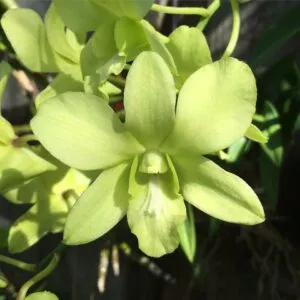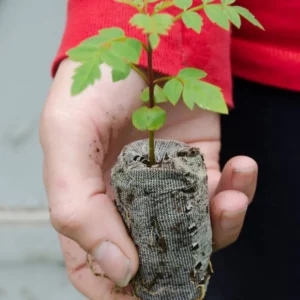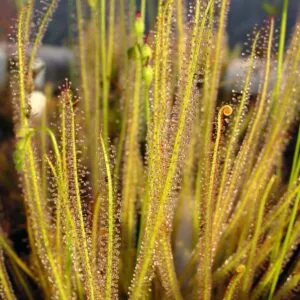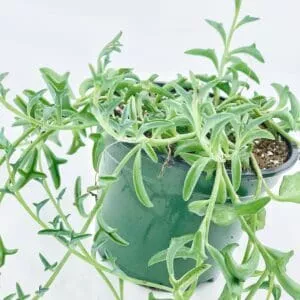No products in the cart.
Table of Contents
Alocasia Polly is a famous houseplant native to South Asia. While they grow small with pale flowers, they are grown for their glossy heart-shaped leaves 🙂. The foliage has ruffled edges with a spectacular creamy white veining.
You can cultivate Alocasia Polly year-round indoors. A note of warning is that this plant is toxic to humans and pets.
Alocasia Polly Care Guide Table
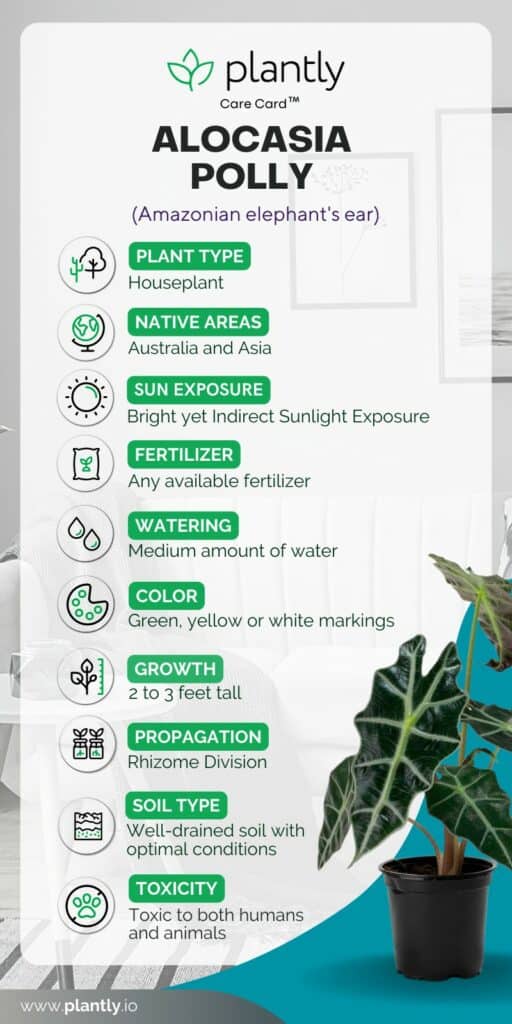
Alocasia Polly Care

The care for Alocasia Polly is relatively easy as it is an easy-growing plant. Please place it in a spot with dappled light, high humidity, warm temperatures, and moist soil.
Note:
Like most elephant ear plants, the Alocasia Polly is invasive in wetland areas like the Gulf Coast. So, before planting your Polly, please consult with the state-local extension to check if it is invasive. Or you can keep it growing indoors.
Best Potting Mix
Provide your Alocasia Polly with well-draining soil, whether grown indoors or outdoors. This keeps the soil airy and allows the water to drain away from the roots to prevent root rot. So, the soil must be moist but not soggy.
How to Water Alocasia Polly
The soil needs to remain moist but not soggy. So, finding a delicate balance is essential to prevent root rot and too-dry soil leading to dormancy. Avoid getting the foliage wet when watering, as it can lead to plant diseases. During winter, refrain from watering your plants and only water when the topsoil dries.
In stock In stock In stock In stock
Free Shipping
$39.99
Sold By:
Aloha Hawaii Orchids
$44.99Dendrobium Aridang Green 4″ Pot Blooming size
Rated 4.65 out of 5 based on 268 customer ratings00
Sold By:
Aloha Hawaii Orchids
$47.96
Sold By:
Carlo's Plant Farm
6 JASMINE DOWNY – LIVE STARTER PLANTS LESS THAN 12 INCHES TALL
Rated 5.00 out of 5 based on 22 customer ratings00
Sold By:
Carlo's Plant Farm
Free Shipping
$29.99
Sold By:
Trees Again Nursery
Blue Jacaranda Trees – Jacaranda mimosifolia – 3 starter plugs
Sold By:
Trees Again Nursery
$6.99
Sold By:
BubbleBlooms
Haworthia pumila, Royal highness, lace aloe, Pearl Plant, Tulista pumila, Haworthia margaritifera in a 2 inch pot super cute
Rated 4.81 out of 5 based on 279 customer ratings00
Sold By:
BubbleBlooms
Ideal Lighting
Provide your Alocasia Polly with bright, indirect light in an east-facing window. If you have a bright space, use sheer curtains to filter the harsh sunlight and help protect the leaves from burning. Direct sunlight will leave the plant’s leaves looking pale and washed out.
Temperature Requirement
Provide your Alocasia Polly with temperatures above 65 degrees Fahrenheit to thrive. Standing in lower temperatures will kill your plant, which is best kept out of drafty and cold areas. The ideal environment is one with high humidity levels, like the bathroom.
Alternatively, you can group your plant with other moisture-loving plants.
Fertilizer
You can fertilize Alocasia Polly during the growing season using an organic houseplant fertilizer. Dilute it to half-strength and use it every two weeks in spring. You can then stop fertilizing as summer ends.
Pruning Alocasia Polly
The tropical plant is a slow-growing plant indoors and needs no pruning. You only trim your plant when you want to shape or control the growth.
You can cut back damaged or dead leaves in the growing season to put out energy for new growth. Remember to use sterilized shears or pruners and cut the leaves back to the stem.
A good idea is to cut back spent flower heads to promote healthy growth.
Propagating
You can only propagate Alocasia Polly when it grows from two bulbs and has two leaves using division. So, if your mature plant starts crowding the pot, the best solution is division. The best time to propagate is in spring and summer when actively growing. Here are some tips on how to do this.
- Remove your plant from the pot and use your fingers to remove the soil around the roots. You may notice some corms that are dormant bulblets. You can replant them in fresh soil with the rest of the plant sprout.
- Now, separate the rhizomes using your fingers and avoid cutting them rhizome.
- Replant each clump in fresh soil in a suitable pot and give them water.
- Keep the soil moist and place them in bright, indirect light in a warm spot.
In stock In stock In stock In stock
$18.00
Sold By:
Beauties & Beasts
Cactus Succulent- Haworthia maughanii x truncata
Rated 4.83 out of 5 based on 24 customer ratings00
Sold By:
Beauties & Beasts
$15.99
Sold By:
BubbleBlooms
Homalomena Selby, 4 inch, Variegated Queen of Hearts, shield plant
Rated 4.81 out of 5 based on 279 customer ratings00
Sold By:
BubbleBlooms
$20.00
Sold By:
Beauties & Beasts
Carnivorous- Drosera filiformis
Rated 4.83 out of 5 based on 24 customer ratings00
Sold By:
Beauties & Beasts
$19.99
Sold By:
BubbleBlooms
String of Dolphins! Curio x peregrinus / Dolphin necklace, flying dolphins / dolphin plant / Senecio hippogriff / String of Dolphins Plant
Rated 4.81 out of 5 based on 279 customer ratings03
Sold By:
BubbleBlooms
Alocasia Polly Potting and Repotting
The potting requirement of the Alocasia Polly you can do every two years when the plant becomes root-bound. The best time to do this is in spring when it comes out of dormancy.
Use a container that is one size larger, like a plastic or glazed pot. Refill the container with fresh soil and plant the root ball at the same soil level as in the previous pot.
Overwintering
Indoor Alocasia Polly can stop growing in winter and look a bit limp. It might drop its leaves and normal when exposed to cold temperatures, dry soil, and less light.
All you do is cut back on your watering until spring or avoid it entirely by using a grow light and keeping it in a spot at 70 degrees Fahrenheit temperature.
Alocasia Polly Varieties and Similar Plants
Other Alocasia varieties are available online, and here are some excellent examples with striking features.
Zebrina

The Zebrina variety has an arrow or shield shape. It can be a noteworthy plant due to its zebra-patterned markings of yellow and black color.
Dragon Scale
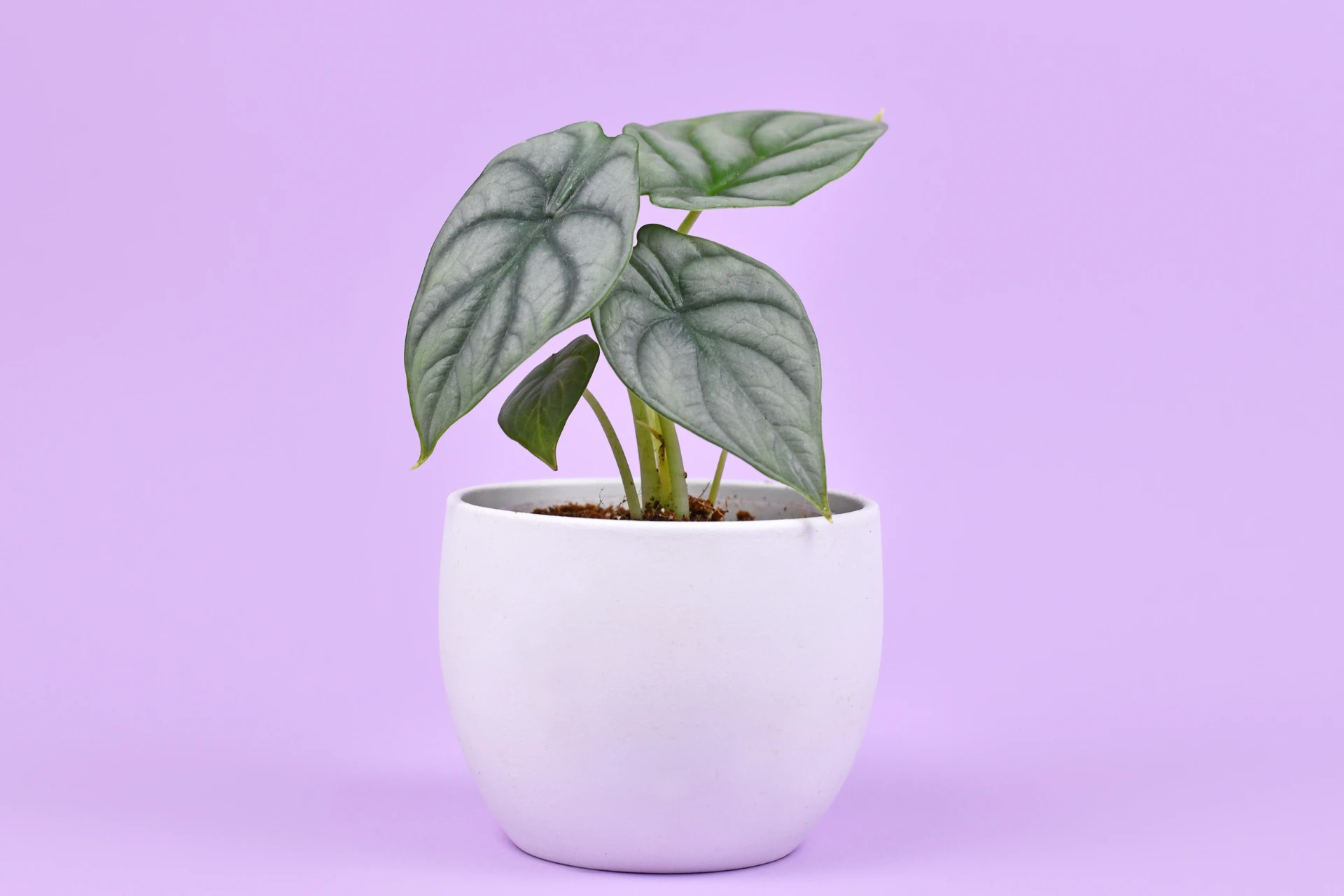
The ‘Dragon Scale’ plant is another alocasia variety with silvery green and dark green leaves. The color of the said variety is directly opposite to that of alocasia.
Black Velvet

The ‘Black Velvet’ plant has black leaves with a heart in shape. The plant also has silver-white veins in its leaves.
Sanderiana

The Alocasia sanderiana has dark green leaves with a dark red color underneath every leaf. The Alocasia sanderiana is native to the Philippines’s Misamis Occidental and Bukidnon provinces. However, the said species are critically endangered.
Alocasia Polly Diseases & Pests
The Alocasia Polly can be bothered by common houseplant pests like scale, aphids, mealybugs, and spider mites. If you notice these insects on the foliage, you can remove them using neem oil or rubbing alcohol.
Remember to place your plant in quarantine to prevent infestations from spreading further.
Brown patches on the leaves
The appearance of the brown patches indicates that the sunlight exposure has scorched up the plant. To prevent this, you can move the plant away from the direction and place it in a spot where it is mostly shaded.
Leaves turning yellow
When the leaves of the plants appeared yellowish, this could indicate that the alocasia had been overwatered. Too much or too little water can cause the plant’s leaves to become yellow. Another reason the leaves of plant alocasia turn yellow is because the alocasia was exposed to direct sunlight.
Frequently Asked Questions
The Alocasia Polly plant is poisonous to humans when ingested. Although, this houseplant should also be out of the reach of pets as it could also poison them.
Depending on the location. In tropical areas, Alocasia Polly loves to be misted since they prefer a humid environment. In the winter, you can keep them in a warm space with occasional misting.
The difference between the alocasia Polly and the Alocasia Amazonica can be seen in their size. The Alocasia Polly plant is more minor than Alocasia Amazonica.
When we talk about which one is more compacted than the other, Alocasia Polly has the edge over Alocasia Amazonica.
Alocasia Polly can be moderately challenging to care for. It requires bright, indirect light, high humidity, and consistent watering. Temperature fluctuations and improper care can cause leaf issues. With proper attention to its specific needs, it can thrive and add beauty to your indoor space.
Whether you want to buy, sell, or simply reach out to other plant enthusiasts, Plantly is the right place to be!
-
Free Shipping$39.99Sold By: Aloha Hawaii Orchids
$44.99In stock
Dendrobium Aridang Green 4″ Pot Blooming size
Rated 4.65 out of 5 based on 268 customer ratings00Sold By: Aloha Hawaii Orchids -
$47.96Sold By: Carlo's Plant Farm
In stock
6 JASMINE DOWNY – LIVE STARTER PLANTS LESS THAN 12 INCHES TALL
Rated 5.00 out of 5 based on 22 customer ratings00Sold By: Carlo's Plant Farm -
Free Shipping$29.99Sold By: Trees Again Nursery
In stock
Blue Jacaranda Trees – Jacaranda mimosifolia – 3 starter plugs
Sold By: Trees Again Nursery -
$6.99Sold By: BubbleBlooms
In stock
Haworthia pumila, Royal highness, lace aloe, Pearl Plant, Tulista pumila, Haworthia margaritifera in a 2 inch pot super cute
Rated 4.81 out of 5 based on 279 customer ratings00Sold By: BubbleBlooms
